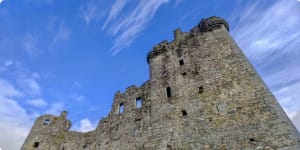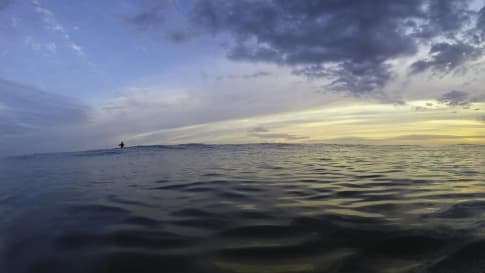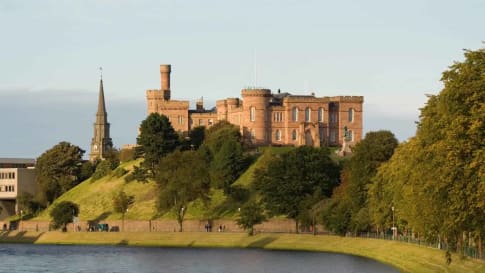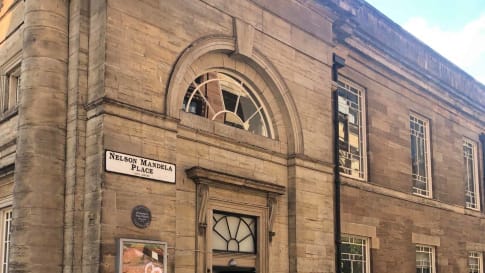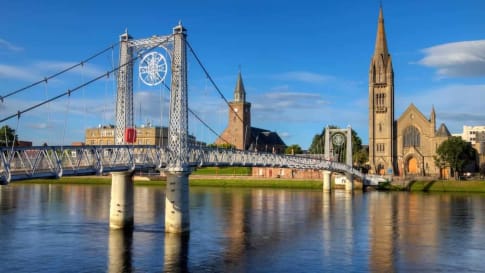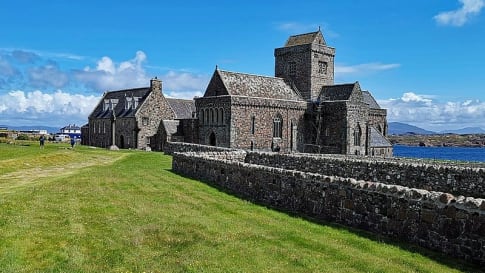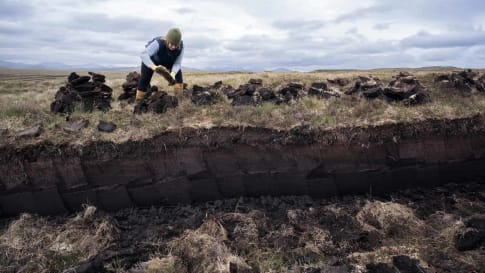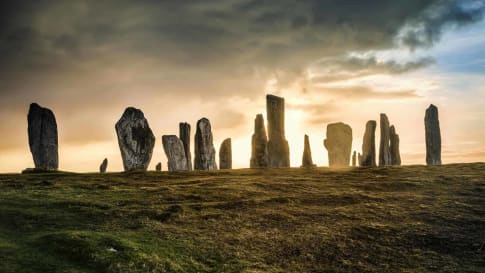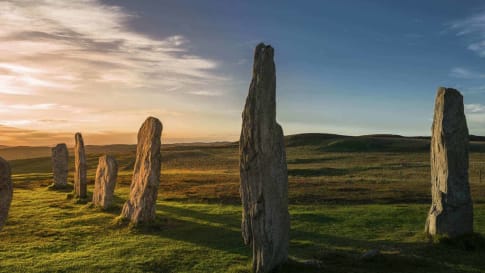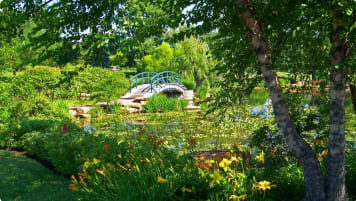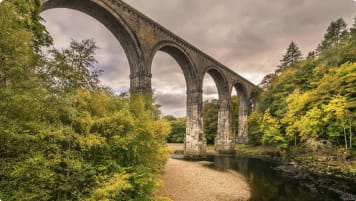Scotland small group tour | Tracing 5,000 years of history
This guided tour of Scotland with a tour leader and local guides includes the isle of Skye, Orkney islands, the Scottish highlands with breathtaking scenery. Edinburgh including the royal mile, Palace of Holyroodhouse, Fort William, Urquhart castle, Stirling castle, loch lomond, Hadrians wall and New Lanark also a UNESCO World heritage site.
From A$16,795AUD
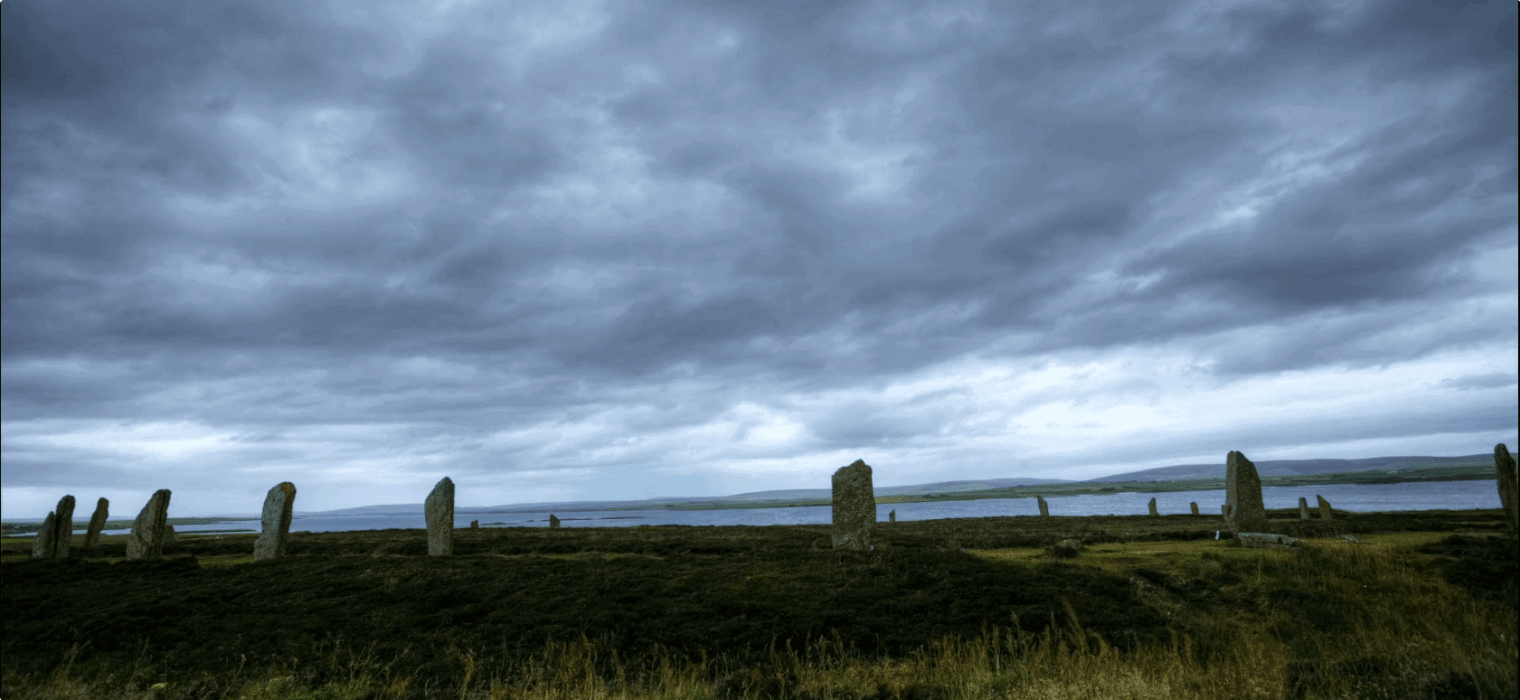
Highlights
- 1. March into Fort George, Britain’s mightiest artillery fortress.
- 2. Explore Stirling Castle, one of Scotland’s best preserved and most fascinating.
- 3. Soak up the atmosphere in the mighty ruined Abbeys of the Borders.
- 4. Be surprised to discover just where the Politicians planned to hide out in case of a nuclear attack.

Departure Dates
| Departure Date | Price |
|---|---|
| 31 August 2025 Ends 21 September 2025 • 22 days A$16,795 Twin A$19,935 Single Available | Selected |
| 29 June 2026 Ends 20 July 2026 • 22 days A$17,395 Twin A$20,650 Single Available | |
| 30 August 2026 Ends 20 September 2026 • 22 days A$17,395 Twin A$20,650 Single Available | |
| 28 June 2027 Ends 19 July 2027 • days A$17,995 Twin A$21,250 Single Available | |
| 13 September 2027 Ends 04 October 2027 • days A$17,995 Twin A$21,250 Single Available |
Tracing 5,000 years of Scotland's history
Scotland has a long and fascinating history. On these small group tours of Scotland, for the mature-aged and senior traveller with an interest in history, we will explore 5,000 years of life on the mainland and on three of the islands. Obviously the topic is vast and we will only have time to examine segments of the country’s long and varied past. We will, however, have time to delve deeply into a number of the events and the lives of many of the people who combined to make this such an interesting field of study.
History of Scotland Tour Itinerary
These tours of Scotland begin on the islands of Orkney in the northeastern coast of Scotland. The islands of Orkney form part of the unique circuit of Islands around Scotland that form part of history of the exploration of the Atlantic by the Scandinavians and in particular expeditions of the Vikings and curiosity for visitors. In the capital, Kirkwall, we will sit down for a welcome dinner with our Program Leader at a local restaurant. Our explorations of Orkney will include visits to Skara Brae, one of the best-preserved Neolithic settlements in Europe, the 12th century St Magnus Cathedral, and the ruins of the adjacent Bishops Palace.
We then travel to the Scottish mainland by ferry, starting with Thurso, the most northerly town in mainland Scotland. Before catching the ferry to Thurso, we will see the Maeshowe Chambered Cairn, a passage grave that is more than 5,000 years old and which carries Viking graffiti on the main chamber's walls, left there when the Norsemen broke into the cairn in the 12th century.
Still in the Scottish Highlands, our coach will transport us west along the scenic north coast, and visit Durness and stop to view the atmospheric Smoo Cave, which has one of the largest entrances to any sea cave in Britain, and on to Ullapool, a picturesque fishing town.
We travel to the east coast and visit Inverness, home to the famous Loch Ness. Here, we will learn more about the bloody Jacobite wars with a visit the Fort George and to the site of the Battle of Culloden, where British troops defeated the Scottish Jacobites. The Jacobites were supporters of the exiled Stuart king James II, taking their name from the Latin form of the king's name (Jacobus). The recently completed Culloden battle site visitor centre allows the visitor the chance to experience the battle in its immersion theatre.
We then spend three nights on the Isle of Skye, the largest island of the Inner Hebrides. Our drive there will be as magical as the destination, passing by Loch Ness, and stopping at Urquhart Castle, which was seized by Edward I when he invaded Scotland, and the beautiful Eilean Donan Castle.
On Skye, we visit Dunvegan Castle, the oldest continuously inhabited castle in Scotland and has been the home of the chiefs of Clan Macleod for 800 years. We will also explore the Museum of the Isles to learn more about the history of the Highlands.
From Skye, we return to the mainland via the ferry from Armadale to Mallaig, heading south to Oban. We take the ferry to the island of Mull before heading towards Iona, where St Columba came from Ireland and established a monastic community there in 563. Great works of art were created here, including the world famous Book of Kells. We head on to Stirling, St Andrews, and Edinburgh. From Edinburgh, we head south to Melrose in the Borders, before travelling north again to end in Glasgow, the second city of the British Empire. Glasgow is a city full of architectural heritage and evidence of quirky humour exemplified by Nelson Mandela Place.
Enjoy not only the history but the beauty of Scotland
As this is Scotland, history will not be our only focus during the journey. It would be impossible to explore the country without enjoying its amazing landscapes. As we travel from Orkney in the north, though the Highlands, Central Lowlands and right down into the Borders, we will be amazed by the splendour of its lochs, glens, mountains and dramatic coastal scenery. Local food, whisky, art, architecture and wildlife will also feature on this truly amazing tour of Scotland.
Take a trip though time and across landscapes steeped in Scottish history. Some of this history is dark with blood and treachery. Learn about Viking raids, clan feuds, battles with the English, Jacobite uprisings, betrayals, murder and mayhem. But also take time to explore the contributions of the great Scottish industrialists, inventors, poets, artists, educators and philosophers. On this tour of Scotland, there is something for everybody, making this tour a unique travel experience.
For more details, click the ‘Top 5’ or ‘Itinerary’ buttons above! If you’re keen to experience this tour, please call or send an email. Or, to book, simply fill in the form on the right hand side of this page.
Articles about Scotland published by Odyssey Traveller
The following list of articles published by odyssey Traveller for mature aged and senior travellers to maximise their knowledge and enjoyment of Scotland when visiting;
- Visiting Scotland
- Scotland & Scotch Whisky
- Visiting Edinburgh places to consider visiting
- Country Spotlight; Scotland
- Nelson Mandela Place; a Glasgow story
- Peat and Scotland
- Glasgow's Architectural heritage
- Stone circles
You can also browse all of our articles or country profile about Scotland. Scotland
External articles about the City of Edinburgh and Scotland for travellers:
Gallery
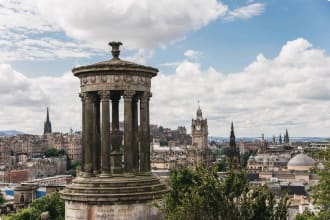

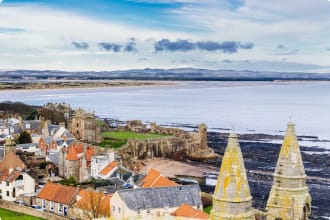
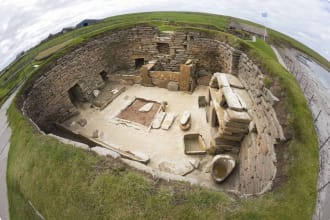
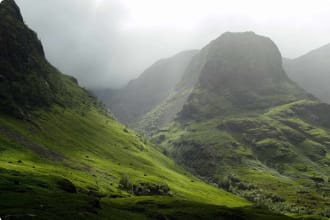
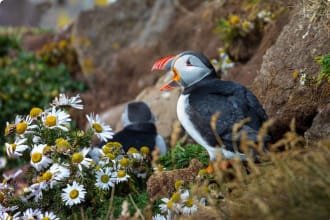

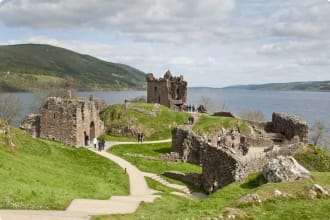
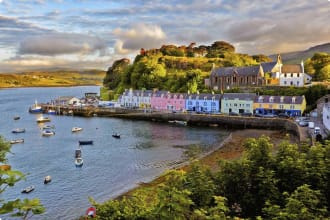
Itinerary
22 days
Day 1: Orkney Islands
Accommodation: Overnight The Shore Hotel or similar
Make your own way to Kirkwall, the capital of the Orkney Islands where you will meet with your program leader in the afternoon.
A welcome dinner will be provided in a local restaurant.
Day 2: Orkney Islands
Accommodation: Overnight The Shore Hotel or similar
Today we begin our exploration into Scotland’s past with a visit to Skara Brae. This Neolithic village allows us to step 5000 years into the past and explore one of Europe’s best preserved prehistoric settlements. You can follow a path overlooking these ancient buildings, still equipped with stone furniture, and step inside a replica house to appreciate the lives of the Neolithic villagers.
While in the northern section of Orkney Main Island we’ll also visit Birsay, with its ruin of a Medieval Earl’s palace, and the Brough of Birsay. If the tide permits we’ll cross to the causeway to the historic island where we can find the ruins of a Norse settlement and a Romanesque church that was a place of pilgrimage in the middle ages.
A visit to the remains of the Iron Age Broch of Gurness and a farm museum will also be included before we return to Kirkwall via the amazing Neolithic Ring of Brodgar and the Standing Stones of Stenness.
Day 3: Orkney Islands
Accommodation: Overnight The Shore Hotel or similar
This morning we begin with a walking tour of Kirkwall which includes visits to the 12th century St Magnus Cathedral and to the ruins of the palace built for the bishops of the cathedral in the 1100s. In the early 1600s the Bishop’s Palace was incorporated into a refined Renaissance palace commissioned by Earl Patrick Stewart, one of Orkney’s most notorious rulers. A visit to the local museum will round off our morning.
In the afternoon we will drive south and explore some of the island’s more recent past. The Italian Chapel, built by Italian prisoners during WWII, is one of the most popular tourist destinations on the island. We will also cross over the Churchill Barriers, built in the 1940s as part of Britain’s naval defence system but now used to link the southern islands to the main island. Our drive takes us past Scapa Flow, an important base for the British Fleet during WWI and where the German Fleet was interned at the end of the war. It was here that the German Commander of the fleet, fearing that his ships would be divided among the Allies, ordered that all ships under his command, should be scuttled.
Visit Highland Park Distillery.
Day 4: Thurso
Accommodation: Overnight Station Hotel or similar
This morning we begin with a visit to Maeshowe Chambered Cairn. Here we’ll enter one of the finest Neolithic buildings in north-west Europe. This chambered tomb is a monument to the skill of the Orkney’s people some 5000 years ago. The cairn is made even more interesting through the graffiti left behind by Vikings who broke into the tomb about 1000 years ago.
From here we drive on to Stromness for a visit to the town and its museum before taking the afternoon ferry to the Scottish mainland and staying in Thurso.
Group dinner this evening.
Day 5: Ullapool
Accommodation: Overnight Royal Hotel or similar.
Today is a day to appreciate the amazing scenery of the Scottish west coast. This morning we head west along the north coast to Durness and stop to view the atmospheric Smoo Cave with its history of ancient murder.
From Durness we drive south along the rugged west coast via Lochinvar to Ullapool where we have some time to explore this 18th century planned fishing village. The town was designed by the great British engineer Thomas Telford as a herring port for the British Fisheries Society.
Group dinner this evening.
Day 6: Inverness
Accommodation: Overnight best Western Palace Inverness or similar
From Ullapool we drive across the country to Inverness on the East Coast. Today we have the chance to learn more about the bloody Jacobite wars with a visit the Fort George and to the site of the Battle of Culloden.
The recently completed Culloden battle site visitor centre allows the visitor the chance to experience the battle in its immersion theatre.
Fort George was built after the Jacobite rebellion was crushed at Culloden in 1746. Here you can gain insight into the life of a Redcoat in a garrison fortress that has barely changed in over 250 years of active service.
Day 7: Portree
Accommodation: Overnight Local 3* hotel
Today we travel west again to the island of Skye where we spend the next three nights. On our way to Skye we travel along mysterious Loch Ness and stop to visit Urquhart Castle. Unfortunately sightings of the monster are exceptionally rare.
Urquhart Castle has a long and dramatic history. This is where St Columba is said to have performed miracles in the 6th century, where acts of chivalry and defiance provided inspiration during the Wars of Independence and where the Macdonald Lords of the Isles struggled with the crown for power.
From Urquhart we continue to Glenelg where we have the chance to explore two more Iron Age brochs. No one is exactly sure just why the Scottish brochs were built but these circular towers date to a period around 2000 years ago. They can be found from the Shetland Islands to Harris and Lewis as well as on Orkney and the mainland but no-where else in the world. The brochs at Glenelg are among the best preserved.
We’ll stop to view romantic Eilean Donan Castle before crossing the bridge to Skye.
Day 8: Portree
Accommodation: Overnight Local 3* hotel
This morning we take a drive around the north of the island before arriving at Dunvegan Castle in time to get some lunch in the café and explore the castle.
Dunvegan is the oldest continuously inhabited castle in Scotland and has been the home of the chiefs of Clan Macleod for 800 years.
On our way back to Portree we will travel down the scenic west coast.
Day 9: Portree
Accommodation: Overnight Local 3* hotel
Day Nine
Today we head south to Armadale Castle. The castle is a ruin but surrounded by splendid gardens. Nearby we will find The Clan Donald Centre which operates the fascinating Museum of the Isles.
We’ll have plenty of time to explore the grounds and museum before heading back to Portree for some free time to relax and assimilate some of the information we’ve been exposed to over the past eight days.
Day 10: Oban
Accommodation: Overnight Regent Hotel or similar
We leave Skye this morning and head back to the mainland via the ferry from Armadale to Mallaig. The drive from Mallaig to Fort William takes us through some stunning scenery and past a number of important historic sites.
Our first stop will be at Glenfinnan where we’ll visit the visitor centre. Glenfinnan was where Bonnie Prince Charlie first rallied his troops for his ill-fated attempt to recover the throne for the Stuarts. The Glenfinnan Monument was erected in 1815 in tribute to all the clansmen who fought and died for the Jacobite cause.
Also at Glenfinnan you can get a good view of the mighty viaduct erected at the end of the 19th century as part of the West Highland Rail service. The viaduct may also be familiar to any of those who watched the first Harry Potter movie.
After Glenfinnan we’ll stop to admire Neptune’s Staircase a series of eight locks designed by Thomas Telford as part of the Caledonian Canal system. Begun in 1803, Telford hoped that the canal would provide immediate employment for the local people and stem the flood of immigration out of Scotland. Scotland was still suffering from the effects of the Jacobite rebellions almost 60 years previously.
From Fort William we drive along the picturesque shores of Loch Linnhe before reaching Oban.
Group evening meal
Day 11: Oban
Accommodation: Overnight Regent Hotel or similar
This morning we take the ferry to the island of Mull before heading towards Iona. This ancient holy place was founded by Saint Columba in 563. Great works of art were created here, including the world famous Book of Kells, but much of this was lost due to a series of Viking raids. The abbey was transformed into a Benedictine Monastery around 1200 but much of what we see today is relatively modern.
Time permitting we will return to the ferry via Macquarie’s Mausoleum and the colourful little town of Tobermory.
Day 12: Dunkeld
Accommodation: Overnight Dunkeld House Hotel or similar
This morning we head south to Kilmartin and Inveraray before turning east for Aberfeldy.
Kilmartin has one of the most important concentrations of Neolithic and Bronze Age remains in Scotland. There are more than 350 ancient monuments within a 10K radius of the village with 150 of these being pre-historic. We will visit the museum and the remains of the fortress of the Scots at Dunadd, a royal centre of Dal Riata.
We’ll have time to stop in the picturesque fishing town of Inveraray before heading on to Aberfeldy to visit the Crannog Centre on Loch Tay. Crannogs were built on artificially constructed islands in Scotland and Ireland in the Neolithic period. The centre has reconstructed a Crannog to provide a glimpse of what life must have been like for these island dwelling people.
Day 13: St Andrews
Accommodation: Overnight Local apartment accommodation
Today we head for the ancient kingdom of Fife. Once the Pictish Kingdom of Fib, established after the Romans left Scotland, Fife has a long and fascinating history.
On our way to St Andrews we visit the NTS mansion, Hill of Tarvit. This Edwardian stately home was transformed from a 17th century house into a mansion in 1904 and now provides a spectacular view into how life was lived by the very wealthy (and their servants) during the Edwardian period.
The historic town of St Andrews is Scotland’s oldest university town and has a number of attractions including the Royal and Ancient Golf Club founded in 1784. Although most people now associate St Andrew’s mainly with golf, it was once one of Scotland’s most significant religious centres, developed as Scotland’s ecclesiastical capital. In St Andrews we can visit the ruins of both the castle and the cathedral. The magnificent medieval ruins of the cathedral stand on a site used for Christian worship since the 8th century. The cathedral, built to house the reputed bones of St Andrew, fell into ruins after the protestant reformation in 1560. The castle, home to the cathedral’s bishops, was for centuries the residence of Scotland’s most powerful churchmen.
Group dinner this evening.
Day 14: St Andrews
Accommodation: Overnight Local apartment accommodation
Today we have a busy day as we continue our exploration into the history of this small section of Scotland.
We begin with a visit to Scotland’s Secret Bunker, Britain’s secret underground government command centre, built in 1951 at the height of the Cold War. The bunker could only be accessed from an inconspicuous “farm house” built specially for the purpose and never lived in. Decommissioned in the 1980s, the bunker is now open to the public.
Our visit to Kellie castle will show us just what the Victorians could do with a medieval castle. The oldest parts of the castle date back to the 14th century but it was overhauled by the renowned artistic Lorimer family in the late 19th century.
The Fisheries Museum in Anstruther provides a good introduction to this historic Scottish industry. At one time the harbour at Anstruther processed and traded more fish than any other harbour in Scotland. Established in the late 20th century, as fishing in the area went into decline, the museum now covers all aspects of the industry at sea and on land.
Day 15: St Andrews
Accommodation: Overnight Local apartment accommodation
This afternoon we drive to Falkland Palace, the royal residence created between 1501 and 1541 by James IV and James V, Stuart kings of Scotland. Falkland Palace was designed by the greatest architects in the country as a pleasure palace and country retreat for the royal family. Here they enjoyed hunting and falconry with the added bonus of returning to their sumptuous quarters at the end of the day. Mary Queen of Scots loved the palace as it reminded her of the French chateaux of her childhood.
The renaissance palace fell into disrepair after 1660 but was “rescued” by the fabulously wealthy 3rd Marquis of Bute in the 19th century. He conserved what he could but also re-created many of the features in his own inimitable style.
Day 16: Stirling
Accommodation: Overnight Golden Lion Hotel or similar
This morning we drive to Stirling with a visit to the National Trust for Scotland’s town of Culross on the way. Culross is Scotland’s most complete example of a town of the 17th and 18th century. In the centre is the ochre-coloured palace with its reconstructed period garden. Culross gives a real idea of what it must have been like to live in a prosperous town of the period.
Group evening meal.
Day 17: Edinburgh
Accommodation: Overnight Motel One Royal or similar
This morning we visit Stirling Castle. Most of what remains of the castle dates from the 15th and 16th centuries. Before the unification with England, Stirling was one of the many royal castles inhabited by members of the Stuart dynasty. James IV was responsible for much of the renaissance building which has been beautifully restored by Historic Scotland making this one of the most interesting of Scottish castles.
In the afternoon we continue to Scotland’s magnificent Millennium Project, the Falkirk Wheel. The wheel, opened in 2002, is the world’s only rotating boat lift and links the Union Canal with the Fort and Clyde Canal. It replaces a series of locks which became disused in the 1930s. We’ll take a ride on the wheel and sail right through a cut in the Roman Antonine Wall!
We’ll stop to view the new 30 metre high, horse head sculpture of the Kelpies on our way to Edinburgh.
Day 18: Edinburgh
Accommodation: Overnight Motel One Royal or similar
This morning we have a guided tour of Edinburgh, taking us from the castle at the top of the Royal Mile to the new parliament building at the bottom.
Visit the new Parliament House and learn about the SNPs push for an independent Scotland.
In the afternoon there will be time to visit the National Museum for Scotland where we can fill in a few of the gaps in our knowledge of Scottish history.
Day 19: Melrose
Accommodation: Overnight Townhouse Hotel or similar
This morning we head for the Borders and visit the oldest continuously inhabited house in the country. Traquair House dates back to 1107 and has been lived in by the Stuart family since 1491. It has been visited by 27 Scottish monarchs including Mary Queen of Scots. During the Jacobite Rebellion the staunchly Catholic family sided with the Jacobite cause and shut the main gates to the house, swearing that they would not be re-opened until a Stuart Monarch was returned to the throne. The gates remain closed and entrance to the grounds is via a side gate!
The ruins of Jedburgh and Dryburgh Abbeys will also be visited today.
Group dinner this evening
Day 20: Glasgow
Accommodation: Overnight Ibis Glasgow City Centre or similar
This morning we have time to pay a visit to Melrose Abbey. Here we can trace the lives of medieval monks in one of Scotland’s largest and richest medieval abbeys. King Alexander II and the mummified heart of Robert the Bruce are buried here.
Close by we find Abbotsford House and have time to visit the home of Sir Walter Scott, one of Scotland’s best loved authors. This grand mansion was financed entirely from the profits made from Scott’s literary endeavours and still contains much of the furniture and artwork collected by the author.
New Lanark is a UNESCO World Heritage site which gives an insight into the development of Scottish industry in the 18th and 19th centuries. New Lanark was established by David Dale as a model industrial village using the recently invented water powered spinning machinery of Richard Arkwright. The philanthropic ideals of the founder were continued by his son-in-law, Robert Owen.
Day 21: Glasgow
Accommodation: Overnight Ibis Glasgow City Centre or similar
Our morning tour of Glasgow will include visits to the Cathedral, Glasgow University, the Hunterian Museum and Kelvin Grove Art Gallery.
In the afternoon we will visit the new transport museum.
Day 22: Glasgow
Tour concludes after breakfast
Includes / Excludes
What’s included in our Tour
- All accommodation and meals as listed in the itinerary
- Transport and field trips as indicated.
- Services of an Odyssey group leader
- Applicable entry fees and services of local guides
- Gratuities and necessary tips
- Detailed Tour Information Booklet
What’s not included in our Tour
- International flights
- Comprehensive travel insurance
- Meals not included on itinerary
- Items of a personal nature such as telephone calls and laundry
Participants must be able to carry their own luggage, climb and descend stairs, be in good health, mobile and able to participate in 3-5 hours of physical activity per day, the equivalent of walking / hiking up to 8 kilometers per day on uneven ground.
Book now
Make it a private tour
Easing your journey
Crossing international borders with restrictions
The list of requirements to travel internationally has changed and will continue to change for several years. Odyssey is here to assist you in managing your way through these requirements:
For more information see our Crossing international borders with restrictions page.
Book With Confidence
If less than 30 days before your tour starts you are unable to travel as a result of Government travel restrictions, Odyssey Traveller will assist you with a date change, provide you with a credit or process a refund for your booking less any non-recoverable costs.
See Terms and conditions for details.
Peace of Mind Travel
The safety of our travellers, tour leader, local guide and support staff has always been our top priority and with the new guidelines for public health and safety for keeping safe for destinations around the world, we’ve developed our plan to give you peace of mind when travelling with us.
See Peace of Mind Travel for details.
Reading List Download PDF
Culloden
Murray Pittock
The battle of Culloden lasted less than an hour. The forces involved on both sides were small, even by the standards of the day. And it is arguable that the ultimate fate of the 1745 Jacobite uprising had in fact been sealed ever since the Jacobite retreat from Derby several months before.
But for all this, Culloden is a battle with great significance in British history. It was the last pitched battle on the soil of the British Isles to be fought with regular troops on both sides. It came to stand for the final defeat of the Jacobite cause. And it was the last domestic contestation of the Act of Union of 1707, the resolution of which propelled Great Britain to be the dominant world power for the next 150 years.
If the battle itself was short, its aftermath was brutal - with the depredations of the Duke of Cumberland followed by a campaign to suppress the clan system and the Highland way of life. And its afterlife in the centuries since has been a fascinating one, pitting British Whig triumphalism against a growing romantic memorialization of the Jacobite cause.
On both sides there has long been a tendency to regard the battle as a dramatic clash, between Highlander and Lowlander, Celt and Saxon, Catholic and Protestant, the old and the new. Yet, as this account of the battle and its long cultural afterlife suggests, while viewing Culloden in such a way might be rhetorically compelling, it is not necessarily good history.
Bare-Arsed Banditti: The Men of the '45
Maggie Craig
They were modern men: doctors and lawyers, students and teachers, shoemakers and shopkeepers, farmers, gardeners and weavers. Children of the Age of Reason, they wrote poetry, discussed the latest ideas in philosophy and science - and rose in armed rebellion against the might of the British crown and government.
Sons of a restless nation that had unwillingly surrendered its independence a mere generation before, some were bound by age-old ties of Highland kinship and loyalty. Others rallied to the cries of 'Prosperity to Scotland' and 'No Union!'
Many faced agonising personal dilemmas before committing themselves to Bonnie Prince Charlie and the Jacobite Cause. Few had any illusions about the consequences of failure. Many met their date with destiny on Culloden Moor, players in a global conflict that shaped the world we live in today.
Combining meticulous research with entertaining and stylish delivery, Maggie Craig tells the dramatic and moving stories of the men who were willing to risk everything for their vision of a better future for themselves, their families and Scotland.
Pursuit of Princes: Volume 5 (The Jacobite Chronicles)
Julia Brannan
THE FIFTH BOOK IN THE CAPTIVATING SERIES WHICH FOLLOWS THE LIVES OF BETH AND ALEX MACGREGOR, THEIR FAMILY AND FRIENDS. The rebellion is over. Prince Charles is in hiding, the Jacobite clans are scattered to the four winds, and in Inverness the Duke of Cumberland plans a brutal retribution against the Highlanders who rose against his father. His intention; to ensure they can never rise again. Alex, knowing Beth to be dead, leads his men into a vicious war of attrition against the British Redcoats, who have destroyed everything in life he ever held dear. Only his desire for revenge keeps him alive. Meanwhile the Duke of Cumberland is hatching a plan that he is confident will reveal the true identity of Sir Anthony Peters, the man who made a fool of the king, the duke and all society, a man he wishes to capture more than anyone else alive. JOIN THE CONTINUING REBELLION OF THE MACGREGORS AND THEIR FIGHT FOR REVENGE AND SURVIVAL IN… THE JACOBITE CHRONICLES
A History of the Scottish People, 1560-1830
T.C. Smout
A beautiful new cover for one of Fontana Press’s hardiest perennials.
‘By far the most stimulating, the most instructive and the most readable account of Scotch history that I have read…this splendid work carries us from Knox to Neilson, from the hot gospel of Calvin to the hot-blast of the smelting process – and incidentally seeks to explain the change. For always, in following this lucid narrative, we see an original mind at work, questioning and explaining, as well as illustrating.’ Hugh Trevor-Roper, Sunday Times
‘This is a fine history of Scotland. It combines rich and deep scholarship with an elegant and lucid style…No one who professes an interest in Scotland can afford to miss reading it.’ Times Literary Supplement
‘This remarkable book leaves the reviewer with little to say except that all Scots, and even Englishmen, who are interested in Britain’s development, should read it. It is admirably proportioned, based on vast reading, and brings all the main topics together.’ Economist
The Scottish Enlightenment: The Scots' Invention of the Modern World
Arthur Herman
'Every Scot should read it. Scotland now has the lively, provocative and positive history it deserves.' Irvine Welsh, Guardian
A dramatic and intriguing history of how Scotland produced the institutions, beliefs and human character that have made the West into the most powerful culture in the world.
Arthur Herman argues that Scotland's turbulent history, from William Wallace to the Presbyterian Lords of the Covenant, laid the foundations for 'the Scottish miracle'. Within one hundred years, the nation that began the eighteenth century dominated by the harsh and repressive Scottish Kirk had evolved into Europe's most literate society, producing an idea of modernity that has shaped much of civilisation as we know it. He follows the lives and work of thinkers such as Adam Smith and David Hume, writers such as Burns and Boswell, as well as architects, technicians and inventors, and traces their legacy into the twentieth century. Written with wit, erudition and clarity, The Scottish Enlightenment claims the Scots' rightful place in the history of the western world.
The Scottish Enlightenment: an Anthology
Alexander Broadie
The Scottish Enlightenment is one of the great achievements of European culture. In philosophy, law, economics, politics, linguistics and the physical sciences, Scots were key players in changing the way the world was viewed. And this explosion of activity still reverberates. It was the age of David Hume, Thomas Reid and Adam Smith, of Adam Ferguson, James Hutton and Sir John Sinclair. In his authoritative introduction, Alexander Broadie emphasises not only the diversity of intellectual discussion taking place in this small country located on the outer edge of Europe, but also the European dimension of this Scottish movement.
After the general introduction, the anthology is arranged thematically - Human Nature, Ethics, Aesthetics, Religion, Economics, Social Theory and Politics, Law, Historiography, Language and Science. These sections gather together well-known and lesser-known writings of the time. Much of the material has not been reprinted since the 18th century. Those with an interest in the Scottish cultural tradition will find many things to hold their attention in this unique book.
